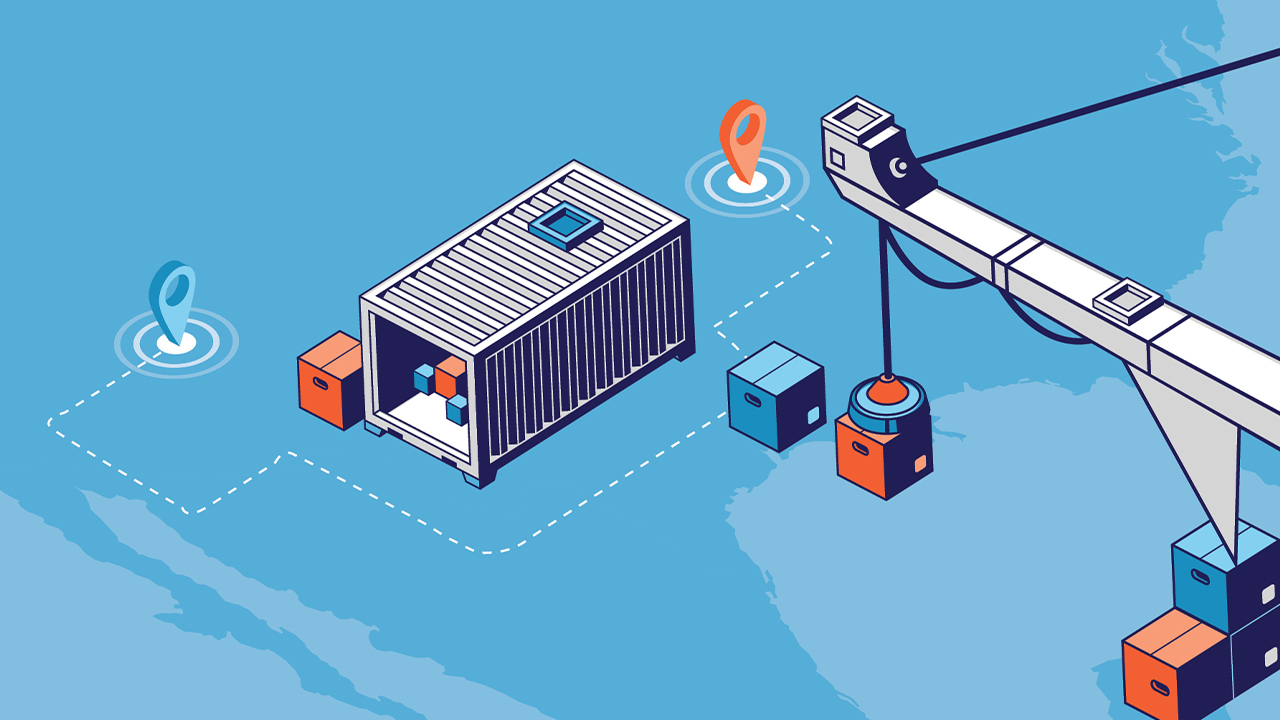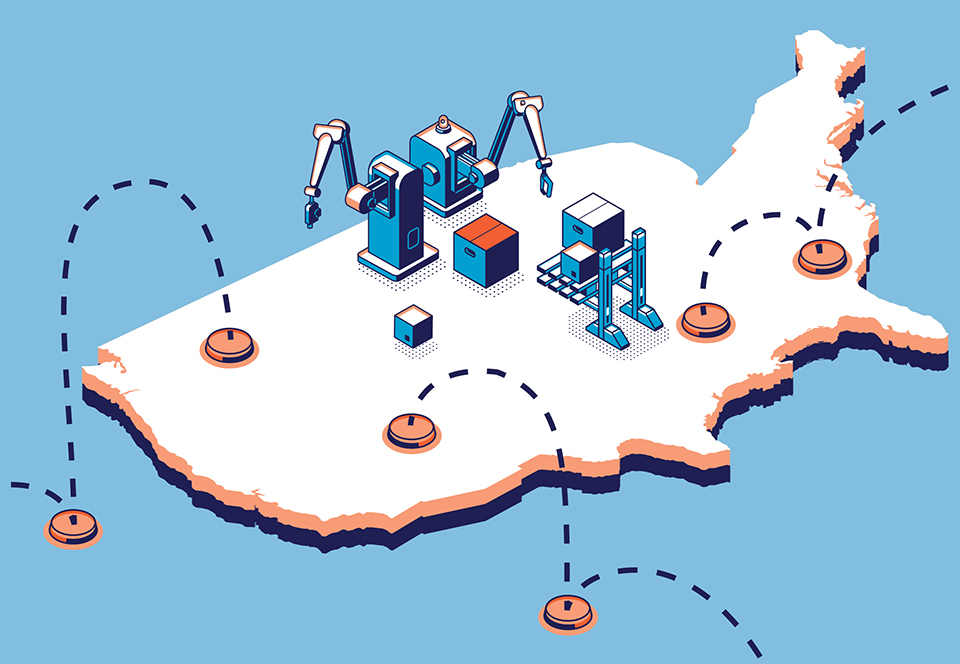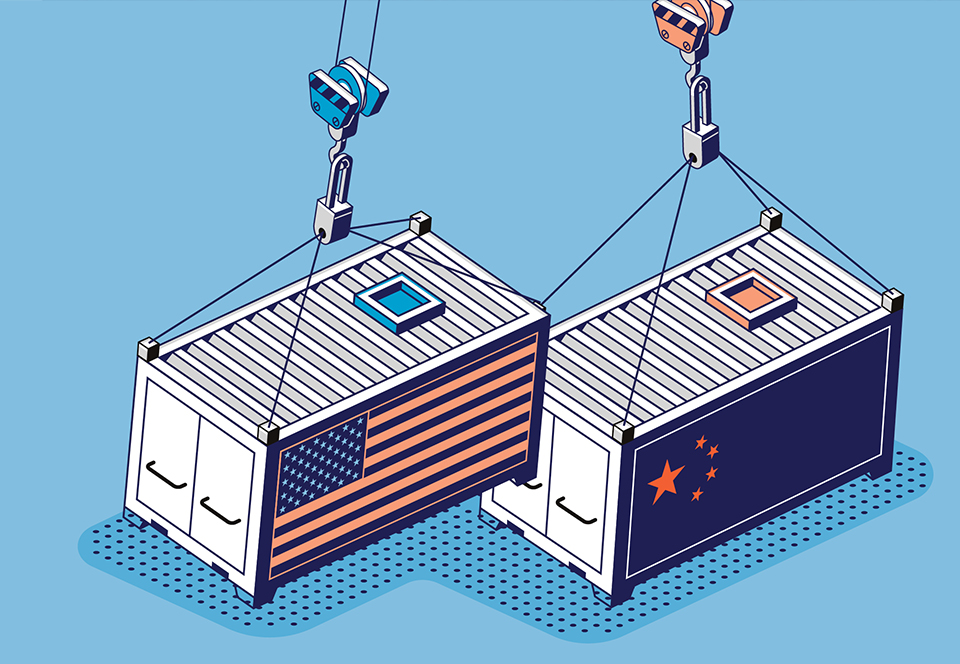All Ashore
With help from their private equity owners, some middle-market companies are reconfiguring their supply chains to meet the growing demand for American-made products.

This story originally appeared in the November/December 2020 print edition of Middle Market Growth magazine. Read the full issue in the archive.
Companies are rethinking their preferred “shoring” prefix. For years, “offshoring” meant minimizing costs and maximizing profit. Then trade tensions and tariffs heightened supply chain anxieties—which were in turn exacerbated by pandemic disruptions.
Combined, those factors have prompted U.S. companies to consider bringing parts of their supply chains home, a process known as reshoring. They’ve also spurred more discussion about nearshoring, which places suppliers in neighboring countries, like Mexico. Both moves reflect companies’ reluctance to depend on suppliers an ocean away.
For manufacturers and their investors, reshoring is not a new idea, but problems caused by COVID-19 have renewed—and amplified—their supply chain concerns. As companies strike a balance between domestic suppliers and low-cost countries, some are questioning the emphasis on reducing cost, at the expense of mitigating risk. Although price still matters, reliability has become a bigger differentiator, and it’s generating new business for some U.S. manufacturers.
Trading Places
At Incline Equity Partners, a private equity firm headquartered in Pittsburgh, reshoring and nearshoring discussions began about three years ago. The pandemic added to Incline’s supply chain concerns—the firm was already “increasingly nervous” about U.S. relations with China, says Jack Glover, managing partner at Incline. “As the owner of these businesses, we want to have control over our supply chain. Our customers feel the same way,” he says, noting that many of Incline’s portfolio companies sell to large U.S.-based customers.
“As the owner of these businesses, we want to have control over our supply chain. Our customers feel the same way.”
Jack Glover
Managing Partner, Incline Equity Partners
Although trade tensions increased companies’ focus on supply chain risks, the pandemic forced them to rethink their solutions. That’s what Larry Naughton, a corporate attorney at law firm Mintz, has observed while working with private equity firms and other investors. As the U.S.-China trade war heated up, companies considered moving their supply chains from China to other Asian countries with good trade relations. With COVID-19, says Naughton, that analysis prompted business leaders to ask themselves, “OK, we don’t want to trade with a key supplier that’s on the other side of any ocean. Can we find one in the United States?”
At Fifth Third Bank, Chief Investment Strategist Jeff Korzenik sees a resurgence in reshoring discussions among middle-market manufacturers. “We’ve been talking about [reshoring] for a decade, but the interest level today is much higher than it has been the last 10 years,” he says.
Turning the Tide
Incline is among the firms translating that interest into action as it helps one of its portfolio companies, a manufacturer of electrical products, shift production from 100% in China to a minimum of 50% in Mexico.

“The reason we went to China in the first place was to be more cost-effective,” Glover says. Now the company has other costs to assess—like tariffs, potential supply disruptions and working capital considerations. Glover notes that by the time orders from China leave the harbor, the portfolio company has paid for 100% of the shipment—and then doesn’t receive it for 30 or 45 days. “So we have all that money tied up,” he says. “With Mexico, because we’re closer, we don’t actually have to spend as much money up front. Then rather than have the stuff out there for 45 days, we send them the money, it ships, and we get it two or three days later.”
Incline started thinking about moving the portfolio company away from China a few years ago and began working on that process in 2019. Glover would like to see the shift to Mexico happen “yesterday,” but it will likely be complete by the end of this year.
He expects the total costs related to manufacturing will be similar to those in China. “They could be 3% to 5% higher nearshored in Mexico than they are in China. But we don’t expect that we’re going to have the tariff issue. That’s the first thing,” Glover says. “Secondly, because it’s significantly closer, you don’t have 30 days on the water, so you need less working capital.”
Preserving working capital has become critical amid the uncertainty caused by COVID-19. For many businesses with overseas suppliers, the pandemic also has interfered with their ability to fulfill domestic orders, creating an advantage for those able to manufacture products closer to their customers.
Ethan Klemperer at Monomoy Capital Partners, a private equity firm based in New York City, says many businesses are seeking a balance of domestic and low-cost country suppliers— a trend that predates COVID, but that has picked up since its onset.
Klemperer, Monomoy’s senior operating executive and head of the operating team, points to a consumer product manufacturer in Monomoy’s portfolio that experienced double-digit revenue increases (year-over-year) for June and July. Because that company has manufacturing facilities in the U.S. and China, it’s been able to meet demand for its products by expanding capacity at its U.S. facility, while its competitors struggled to keep up because most of their production was overseas, Klemperer says.

“Supply chain concerns are driving companies to, at a minimum, review the feasibility of reshoring product.”
Clint Bucholz
General Manager, GLE Precision
Monomoy worked with the management team to develop a more efficient factory layout and production lines, and then spent the next six months implementing the plan. This included targeted SKU (product) reduction, which allowed the U.S. facility to group similar, low-volume products together in one plant. Previously, the products had occupied sections of two plants. “We were then able to take the empty buildings and ramp up production of our core products,” Klemperer says. Those changes helped the company increase production capacity by more than 40% in less than a year. Automation also played a role, says Klemperer. He expects the company will add even more automation to expand capacity further.
Prescription for Reshoring
Although interest in shifting to North American suppliers is creating new business for some companies, the transition isn’t seamless. Supply chain relocation is a slow process—like “poking at a whale with a pencil,” says Fifth Third’s Korzenik. The planning takes time, and it requires addressing challenges posed by the North American market.
GLE Precision, a manufacturer based in Bridgeport, Michigan, is among the companies that are beginning to benefit from the shift toward American manufacturing, even as it works to manage the higher costs associated with U.S. production.
In August, the company was finalizing the reshoring of a medical project involving ejector pins used to form insulin syringes. Clint Bucholz, GLE’s general manager, says he believes the project was previously manufactured in China.
Although that was the company’s only reshoring project at press time, Bucholz sees possibilities for many more, based on conversations he’s had with current and potential customers. “Supply chain concerns are driving companies to, at a minimum, review the feasibility of reshoring product,” he says.
For GLE, which is owned by private equity firm Colfax Creek, customer order sizes range from a single component for research and development, to 20,000 units a year for a “big job,” Bucholz says.
In a typical year, GLE would have about two to four possibilities for “step increase projects,” which Bucholz describes as projects that would increase GLE’s overall business by 15% to 100%, and worth anywhere from $1 million to more than $10 million. “Since COVID, we have seen three to four times this rate, year to date … we’ve got just such an explosion of these opportunities,” he says.
Yet relatively high wages in the U.S. can make it difficult to compete against suppliers in other countries. To help control costs, GLE has turned to automation technology. That reflects a wider trend in U.S. manufacturing, particularly as automation becomes cheaper to implement. Bucholz notes that seven or eight years ago, it could cost around $75,000 to put a robotic arm on a machine—now it might cost about $35,000.
“We’ve been talking about [reshoring] for a decade, but the interest level today is much higher than it has been the last 10 years.”
Jeff Korzenik
Chief Investment Strategist, Fifth Third Bank
He says that a large-scale shift to U.S. suppliers won’t be possible unless another challenge is addressed, too: raw materials. “If you reshore the manufacturing, but a company still has to get their raw material to win those jobs from offshore, it still doesn’t quite get you there,” he says, noting that the cost of U.S. raw materials is still quite high. Says Bucholz: “That plays a heavy part in success in truly reshoring … America needs to develop our raw materials network.”
Enhanced Healthcare Partners (EHP), a private equity firm headquartered in New York City, is doing its part to improve access to raw materials for pharmaceutical manufacturing. Specifically, the firm is looking for investment opportunities in U.S.-based makers of APIs (or active pharmaceutical ingredients) used in prescription drugs.
Most API suppliers have been located overseas historically, but EHP believes there will be increasing demand to produce these components closer to home, after the pandemic revealed the supply chain disruption that can occur when countries limit exports. As of August 2019, 72% of the manufacturing facilities making APIs to supply the U.S. market were based outside the United States (including 13% in China and 18% in India), according to the Food and Drug Administration.

EHP is three years into a five-year plan to invest over $100 million into capacity expansion. Part of that money is for API reshoring investment, but most of it will benefit the three pharmaceutical manufacturers in its portfolio: SCA, Aphena and PAI.
Matt Thompson, partner at EHP, says the firm has always believed that quality would be a differentiator in the highly regulated pharma manufacturing world. That means a high standard for the pharmaceutical products themselves, as well as reliable access to those products through stable supply chains. The customers for EHP’s manufacturing companies—mainly hospitals and doctors’ offices—have always been concerned about supply chain issues, and the pandemic has amplified their fears.
To reinforce supply chain security, EHP’s portfolio company PAI, which manufactures and markets generic oral liquid pharmaceuticals, started a safety stock initiative last year. The company now holds 12 weeks of additional stock on hand for each SKU, and six months’ worth of API. That’s a “meaningful increase” compared with the stock and active ingredients the company kept on hand before, Thompson says, adding that customers have appreciated the reliable access to liquid medications.
In recent months, Mintz’s Larry Naughton has seen other companies reconsider their approach to “just-in-time” inventory. Rather than trying to maximize margins by keeping minimal supply on hand, he says businesses are now thinking, “Maybe we do need to keep a little extra inventory on hand. We can’t be prepared for a nine-month shutdown on our supplier, but what if the supplier is shut down for three weeks?”
“Right now, we’re in one of the cycles where people say, ‘You know what? It’s worth it to pay a little bit extra to have the balanced supply chain.’ It’s about building an organization that can react to changes in the marketplace.”
Ethan Klemperer
Senior Operating Executive, Monomoy Capital Partners
As U.S. pharmaceutical businesses look for domestic partners, Thompson says EHP’s portfolio company Aphena, a pharmaceutical packaging and manufacturing services provider, is seeing more business inquiries, and the company plans to add jobs. In Eaton, Maryland, Aphena has a 110,000 square-foot facility and will be adding a 54,000 square-foot facility adjacent to its existing location. It’s slated for completion by December. The Eaton location currently employs 150 full-time workers and plans to add an additional 100 jobs over the next two years.
Aphena’s three Tennessee locations will add about half-a-million square feet of production capacity, slated for completion in January. The Tennessee locations currently have 340 employees and are projected to add another 50 in the next eight to 12 months.
STAYING FLEXIBLE
Companies have always made trade-offs when managing their supply chains, either to minimize cost or maximize reliability. Some observers see the events of 2020 shifting that dynamic.
“I think the needle moved, maybe not in a game-changing direction, but a little bit more toward resiliency of ‘let’s make sure that the supply chain is going to remain intact,’” Naughton says.
It’s important to stay flexible, because today’s supply chain risk may be tomorrow’s asset. Three years ago, when Monomoy acquired a manufacturer with critical operations in Mexico, that location was considered a key risk. “Now that is one of its best assets, as most of its competitors manufactured in China and are having to deal with tariffs and freight surcharges,” Klemperer says.
At Incline Equity, COVID-19 has heightened awareness of supply chain diversity as well as country of origin, Glover says. “One of our big issues now is, we look at country concentration for vendors,” he says. “Ten years ago, I will tell you this, we were not concerned about a company that was manufacturing all of its products in China. We are now.”

Glover notes that China is only one example. The firm sees risk in having all key suppliers in one country, whether that’s Vietnam, Cambodia or India. Such a scenario would spark caution around a potential investment, he says.
It would concern Glover and his colleagues even more if a manufacturer had a single supplier for a particular component. “Our next question would be, ‘Okay, is it just one vendor, or are there a dozen?’ If there’s a dozen, we feel better,” he says. Having multiple vendors shows a component can be produced elsewhere if needed. But a single vendor may have a specialized process that’s hard to reproduce—which makes it difficult to shift component sourcing to a different region.
Monomoy’s Klemperer notes that companies continue to move back and forth between prioritizing a diversified supply chain, or saving a little money by giving a huge chunk of volume to a sole supplier. “Right now, we’re in one of the cycles where people say, ‘You know what? It’s worth it to pay a little bit extra to have the balanced supply chain.’ It’s about building an organization that can react to changes in the marketplace,” he says. “Because you know there are going to be changes. You just don’t know what they’re going to be.”
Supply Chain Due Diligence
Mintz’s Naughton says investors are now spending more time on supply chain due diligence and asking a new set of questions:
- How has the supplier navigated COVID-related challenges? Were they able to keep supply going to their customers, or was it a complete shut down?
- How financially stable is the supplier? Is the manufacturer tied to a key supplier that might not last another year—or even the next three months?
- Investors are now more careful about suppliers’ customer references, says Naughton, and ask question such as: “In general, what was your relationship and experience with the supplier? But in particular, I want to hear a lot about what’s happened since March 15.”
S.A. Swanson is a contributing editor at Middle Market Growth.


